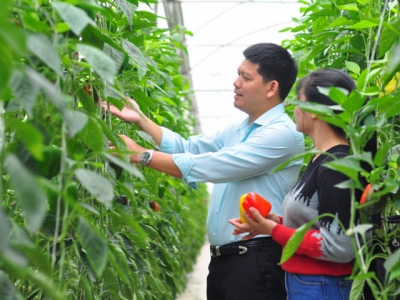Vietnam consults world experience on green agriculture development

World economic experts and agricultural policy researchers have shared developed countries’ experience in the field of green agriculture.
Organic agricultural model in Lam Dong. Photo: Minh Hau.
At the High Level Policy Dialogue (HLPD) “Transition to a Green and Low-Emissions Food System” on November 30th, world economic experts and agricultural policy researchers shared lessons from developed countries such as China, the USA, and European countries in the field of green agriculture.
The parties gave proposals for Vietnam's agriculture to be transformed towards green and greenhouse gas emissions reduction through agricultural production activities.
Lessons from the USA and China
China had had to import large quantities of food since the early 2000s despite rapid growth in agricultural production. China paid a heavy price for its output growth in previous years with resource and environmental degradation that threatens sustainable development.
In 2015 China has issued the Strategy of Food Reserves in Technology which enhances and innovates research and development capacity particularly biotechnology and digital technology.
China spent USD 4.1 billion on agricultural research and development in that year. The nation's 2015 Strategy of Food Reserves in Soil set limits on land cultivation (120 million ha) and promoted improvement of land quality based on the construction of high-standard farms.
“From the lessons of China, in order to raise people's incomes, improve food security and develop sustainable agriculture, Vietnam urgently needs commitments in institutional reform, policy support and investment in agriculture,” said Prof. Jikun Huang.
Sharing experience on reducing greenhouse gas emissions in the USA, Mr. William Hohenstein, Director of USDA's Office of Energy and Environmental Policy (OEEP), said that responding to climate change has been a top priority for US President Joe Biden since his inauguration.
Mr. William Hohestein elaborated on the USDA’s climate resilience and adaptability improvement action plan. Accordingly, the nation’s agricultural sector focuses on investing in land and forest health; raising awareness and increasing communication to promote climate-smart adaptation strategies; expanding accessibility and provision of regional and local climate data; strengthening research and development support for climate-smart practices and technologies; using USDA’s Regional Climate Centers to deliver science, technology, and adaptation initiatives.
The USDA representative also expressed his delight at Vietnam's participation in joint commitments and initiatives to strengthen and accelerate innovation and creativity in the agricultural industry, and support climate resilience actions and accelerate agricultural transition such as COP26 and the Coalition of Action on Sustainable Productivity Growth (SPG).
Advanced technology application and the involvement of private sector
According to Mr. Benoit Bosquet, Director for Sustainable Development in the Asia-Pacific region of the World Bank (WB), More than half of the world's population consumes rice and cereals, and the production of these products is linked to greenhouse gas emissions.
Rice production is responsible for 10% of total CH4 emissions as well as contributing to global CO2 and NO2 emissions. In the case of Vietnam, in the rice industry alone, every 1 ton of wet rice produced produces 0.8 tons of CO2 equivalent (CO2e). Greenhouse gas emissions from wastes and by-products from rice drying and milling are even greater.
Reducing emissions amid agricultural production is extremely important, especially when each country is implementing its commitments in the Nationally Determined Contributions (NDCs) report under the United Nations Framework Convention on Climate Change (UNFCCC). Improving the efficiency of these movements can help Vietnam greatly reduce greenhouse gas emissions.
Mr. Steven Jaffee, WB Senior Specialist, said that Vietnam needs a technical and technological foundation to promote farmers' participation in sustainable agricultural development, thus close coordination with international organizations and research institutes.
Moreover the structure of Vietnam's agricultural sector needs to ensure investment attraction, constructing more sustainable, green transformation models so that farmers can see the benefits.
Harnessing the capacity of the private sector to reduce carbon emissions in agriculture and promote the production of local products was also mentioned in the forum by Mr. Ernest E. Bethe III, Principal Operations Officer of the International Finance Corporation (IFC).
Vietnam is a major agro-products exporter. Along with the changes in the world, the Vietnamese market has also witnessed strong movements.
Vietnamese consumers are constantly experiencing a high increase in incomes and urban populations. They expect safer, higher-quality products in their daily purchases and are developing an interest in premium products. The market is shifting from dominant rice to other high-valued food.
Mr. Ernest E. Bethe III said that all of the above has great implications for the private sector - which is increasingly interested in the issue of decarbonization in agriculture. In the next 10 years, businesses are required to further invest in production and distribution systems that support the decarbonization process.
Có thể bạn quan tâm
Phần mềm

Phối trộn thức ăn chăn nuôi

Pha dung dịch thủy canh

Định mức cho tôm ăn

Phối trộn phân bón NPK

Xác định tỷ lệ tôm sống

Chuyển đổi đơn vị phân bón

Xác định công suất sục khí

Chuyển đổi đơn vị tôm

Tính diện tích nhà kính

Tính thể tích ao hồ



 The soil nutrient map helps to save fertilizers
The soil nutrient map helps to save fertilizers  Coffee landscape model benefits farmers
Coffee landscape model benefits farmers